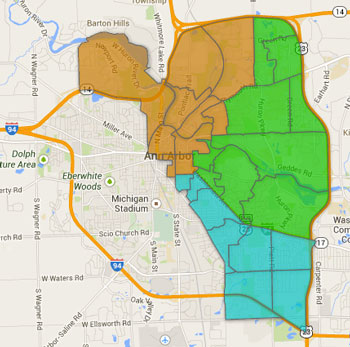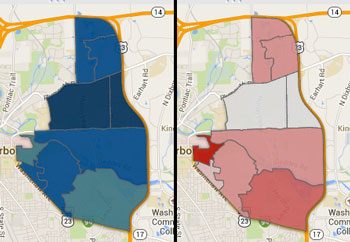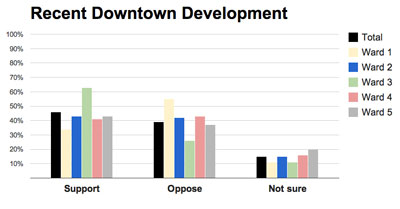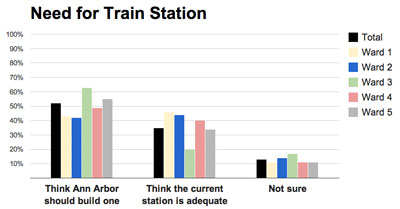How Ann Arbor Council Races Were Won
The results of city council Democratic primary elections held in the city of Ann Arbor on Aug. 5 can fairly be considered determinative of Nov. 4 election outcomes – because no Republicans or independents filed petitions to qualify for the ballot.

City council races were actively contested in only three of Ann Arbor’s five wards in the Democratic primary: Ward 1 (orange), Ward 2 (green) and Ward 3 (teal).
November will see at least three newcomers to the 11-member council – Kirk Westphal in Ward 2, Julie Grand in Ward 3, and Graydon Krapohl in Ward 4. Westphal and Grand won their respective Democratic primaries that featured no incumbents. Both candidates were coming off unsuccessful council campaigns last year – against Jane Lumm (Ward 2) and Stephen Kunselman (Ward 3), respectively.
Westphal received 1,819 votes (59%) to Nancy Kaplan’s 1,261 (41%) in a race that was anticipated to be somewhat closer. Grand received 1,516 votes (51.1%) compared to Bob Dascola’s 794 (26.8%) and Samuel McMullen’s 616 (20.8%). That gave a decisive result to a Ward 3 race that had been fraught with legal disputes – about Dascola’s eligibility to appear on the ballot in the first place; and then about how to count misprinted absentee ballots, which omitted Dascola’s name.
Krapohl’s race did not even appear on the Aug. 5 ballot – because he was unopposed in the Democratic primary and no Republican qualified for the ballot. The omission of the race from the ballot under those conditions is stipulated in a clause of the city charter.
Krapohl will be filling the seat to which Democrat Margie Teall did not seek re-election. Westphal will almost certainly be filling the Ward 2 seat that Sally Petersen left to pursue an unsuccessful mayoral campaign. And Grand will almost certainly be elected to fill the seat vacated by Christopher Taylor, who ran a successful campaign for mayor.
Taylor, who’s currently a councilmember representing Ward 3, will be the Democratic nominee in the Nov. 4 general election against independent Bryan Kelly. Assuming Taylor does prevail, he will remain on the council as mayor. And among the 10 councilmembers who represent one of the five wards, he’ll almost certainly see a total of seven returning faces, including the two incumbents who prevailed in the Aug. 5 primaries.
That’s because those two incumbents, like the new Democratic council nominees, will also be unopposed on the November ballot. First-term Ward 1 councilmember Sumi Kailasapathy prevailed over Don Adams, who was seeking elected office for the first time. Kailasapathy received 1,113 votes (56.8%) compared to 840 (42.8%) for Adams.
And first-term Ward 5 councilmember Chuck Warpehoski prevailed over Leon Bryson, who had announced he was withdrawing from the race after the deadline to remove his name from the ballot. Bryson still collected 674 votes (18.6%), but Warpehoski’s total was 2,936 (81%).
Those three newcomers and two incumbents will join the five councilmembers who are currently in the middle of their two-year terms: Jane Lumm (Ward 2), Jack Eaton (Ward 4) and Mike Anglin (Ward 5) – as well as Sabra Briere (Ward 1) and Stephen Kunselman (Ward 3), who were unsuccessful in their mayoral bids.
Below are some maps illustrating the geographic distribution of votes in the three actively contested city council races, as well as some limited analysis of the Ward 2 race in terms of questions that were part of a pre-election poll conducted by Public Policy Polling.
Ward 1 Maps
In the Aug. 5, 2014 Democratic primary, first-term Ward 1 councilmember Sumi Kailasapathy prevailed over Don Adams, who was seeking elected office for the first time.

Maps are shaded by precinct based on the percentage of votes received by each candidate. Kailasapathy’s percentages are shown in red; Adams’ percentages are shown in blue.
Kailasapathy received 1,113 votes (56.8%) compared to 840 (42.8%) for Adams. That’s a similar percentage breakdown to the 2012 Democratic primary race that Kailasapathy won against Eric Sturgis. In the 2012 race, Kailasapathy received 863 votes (58%) compared to 628 (42%) for Sturgis.
Kailasapathy lost one precinct to Adams – Precinct 1-10. The tally there was 273 for Adams compared to 211 for Kailasapathy. That precinct includes Arrowwood Hills Cooperative Housing, where Adams lives.
When The Chronicle dropped by the Precinct 1-10 polling station on its Election Day tour of the polls, Adams indicated he’d be spending the whole day at that precinct, saying “This is my family.”
In the color-shaded maps that are included in this article, Precinct 1-10 stands out in the central northern part of the ward.
In 2012, Kailasapathy was not as strong in Precinct 1-10 as she was in other parts of Ward 1, but still prevailed there against Sturgis. That year she lost a different precinct to Sturgis – Precinct 1-5, just to the south of Precinct 1-10 – by a tally of 123 to 157. That precinct was the home precinct of Sturgis. This year she prevailed there against Adams – by a tally of 177 to 136. Sturgis worked for Kailasapathy’s campaign this year.
Ward 1 Maps: Adams
Ward 1 Maps: Kailasapathy
Ward 2 Maps
In the Ward 2 city council race, Kirk Westphal received 1,819 votes (59%) to Nancy Kaplan’s 1,261 (41%) in a primary that was anticipated to be somewhat closer.
Westphal currently serves on the city planning commission, with a term ending in July 2015. In November each year, the city council makes an annual appointment from its own members to the planning commission – a position currently held by Sabra Briere (Ward 1). Regardless of how the council handles that appointment this year, an additional appointment will need to be made to the planning commission from the citizenry at large – to fill the spot that Westphal will be giving up to serve on the council.

Ward 2 precincts color-shaded according to percentage of the vote received: Westphal (blue) and Kaplan (red).
Westphal’s decisive margin in the Aug. 5 primary – of nearly 3 to 2 – saw Kaplan receiving about the same percentage of the vote as Westphal did last year in the 2013 November election in Ward 2 – a race in which Jane Lumm prevailed.
One of the two precincts Westphal won that year was percentage-wise especially strong for him this year against Kaplan – Precinct 2-1 in the middle of the ward. In 2-1, Westphal received 73% of the vote this year. But it was comparatively lightly voted – with the actual tally just 77 to 28 votes. The neighboring Precinct 2-8, just to the west of 2-1, was also nearly as strong for Westphal percentage-wise at 68%, but offered a much greater plurality. The tally was 289 to 136.
Kaplan did not win any precincts. The sparsely voted 2-2 was split three votes apiece for both candidates. Kaplan’s home base of support in the southern part of the ward near Huron Hills golf course delivered the closest meaningful total for Kaplan – at 48%. Kaplan had campaigned in part on her participation in an effort a few years ago to defend Huron Hills golf course from a future that’s different from its status as a public park.
Ward 2: Poll Question Breakdown
Westphal had campaigned in part by contrasting himself with Kaplan with respect to three points: (1) attitude toward downtown development (as a planning commissioner, Westphal voted to recommend 413 E. Huron for approval); (2) public transportation (Westphal supported the recent AAATA millage, which was approved by voters in on May 6); and (3) development of rail-based transportation options (Westphal supports investment in a new rail station).
Two of those issues were touched on in a pre-election poll of Ann Arbor voters, which was conducted by Public Policy Polling (PPP). Voters were asked their opinions about recent downtown development and their perceptions of a need for a new train station.
In general, do you support or oppose the increased development being approved and built downtown in recent years?
Do you think Ann Arbor should build a new train station/transit center, or do you think the current train station is adequate?
Base on those poll results, Westphal’s general position on those topics seems to resonate with more Ann Arbor voters citywide than not. A slim majority of Ann Arbor residents think Ann Arbor needs a better train station: The need for a new train station polled at 52%, while the alternate view – that the current station is adequate – polled at 35%. The poll indicated 46% support for the downtown projects that have been approved and built in recent years, and with opposition at 39%.
The poll had 435 respondents citywide, which means that the numbers for each of the individual five wards were fairly small. So conclusions about each ward’s cut of the data would need to be viewed with even more caution than the poll’s overall results.
But the breakout by ward on those two pre-election poll questions showed a great deal more ambiguity amongst Ward 2 voters than among voters citywide. Contentment with the current train station polled two points better in Ward 2 than a perceived need to build a better one – 44% to 42%. And support for recent downtown developments showed a split of 43% to 42%. Westphal’s ultimately successful campaign strategy did not appear to try to straddle the fence on those issues. Those results are presented in Charts 1 and 2 below.

Chart 1: From July 28-29, 2014 pre-election survey of 435 likely Democratic primary voters by Public Policy Polling. Chart by the Chronicle.

Chart 2: From July 28-29, 2014 pre-election survey of 435 likely Democratic primary voters by Public Policy Polling. Chart by the Chronicle.
Also part of the Ward 2 campaign was an explicit association of Westphal with mayoral candidate Christopher Taylor by the Michigan Talent Agenda’s set of endorsements. Westphal and Taylor also shared several donors to their campaigns. To the extent that voters perceived Westphal as similar to Taylor, that may have worked to Westphal’s benefit – because according to the PPP poll, voters have a favorable opinion of Taylor – not just citywide, but also in Ward 2.
Poll respondents were asked a different question about current mayor John Hieftje – related to job performance, as opposed to a favorable or unfavorable opinion of the person. But on that question Hieftje’s approval showed a different pattern from Taylor’s. Both men polled positively citywide, but more Ward 2 voters disapprove of Hieftje’s job performance than approve of it. There’s been a smattering of commentary over the last few years attempting to associate Westphal with Hieftje – based on the fact that it was Hieftje who nominated Westphal to the planning commission. Based on the outcome of the primary, that appears to be an association that is not felt strongly enough by voters to make a difference.
Results by ward on poll questions about Taylor and Hieftje are presented in Chart 3 and Chart 4.

Chart 3: From July 28-29, 2014 pre-election survey of 435 likely Democratic primary voters by Public Policy Polling. Chart by the Chronicle.

Chart 4: From July 28-29, 2014 pre-election survey of 435 likely Democratic primary voters by Public Policy Polling. Chart by the Chronicle.
Ward 2 Maps: Westphal
Ward 2 Maps: Kaplan
Ward 3 Maps
In the three-way Ward 3 race, Julie Grand received 1,516 votes (51.1%) compared to Bob Dascola’s 794 (26.8%), and Samuel McMullen’s 616 (20.8%).
That gave a decisive result to a Ward 3 race that had been fraught with legal disputes – about Dascola’s eligibility to appear on the ballot in the first place; and then about how to count some misprinted absentee ballots, which omitted Dascola’s name.
Concern about how to count those ballots – if a voter did not send in a replacement ballot – had been heightened by the fact that Ward 3 has historically featured close races. The 2009 primary race was decided by just six votes, which triggered a recount.
In the end, Grand eked out an actual majority of votes, comfortably outpolling Dascola and McMullen.
That outcome was based in part on Grand’s strength in the two precincts nearest to the center of the city near the Burns Park area – 3-3 and 3-4. Grand’s support in those precincts approached 60%. Grand also won Precinct 3-3 in her race against Kunselman last year, which she narrowly lost overall.
Like last year, Grand was not quite as strong in the mid-outer precincts of 3-8, 3-7 and 3-6, but still had more votes than Dascola and McMullen in every precinct in the ward.
The pattern of Grand’s support in the ward was similar but not identical to that of mayoral candidate Christopher Taylor’s in Ward 3 – his home ward. Precinct 3-6 was the only precinct won by Stephen Kunselman in the mayoral race (his home precinct). Grand still polled 41% there, after losing the Democratic primary to Kunselman last year. Grand had publicly endorsed Taylor in his mayoral race.
Precinct 3-6 was also one of the strongest precinct for Bob Dascola – among those precincts with a significant turnout. Dascola had publicly endorsed Kunselman in his mayoral race.
In the 2013 primary, Grand had also won Precinct 3-5 in the south of the ward. And that precinct was one of her stronger precincts again this year. Grand received nearly 58% of the vote in that precinct.
McMullen’s strongest precinct was 3-7, where he received nearly 28% of the vote. That’s the home neighborhood of Jeannine Palms, a long-time parks and environmental activist who had publicly endorsed McMullen and campaigned on his behalf.
Ward 3 Maps: McMullen
Ward 3 Maps: Dascola
Ward 3 Maps: Grand
The Chronicle could not survive without regular voluntary subscriptions to support our coverage of local elections. Click this link for details: Subscribe to The Chronicle. And if you’re already voting for The Chronicle, please encourage your friends, neighbors and colleagues to help support The Chronicle, too!





If you assume (perhaps incorrectly) based on endorsements that Taylor / Warpehoski / Grand / Krapohl / Westphal make up one faction and Lumm / Anglin / Kunselman / Eaton / Kailasapathy make up the other faction, with Briere being independent, there’s two interesting results that emerge.
1) No ward leans towards one faction or the other. Essentially each faction is drawn from all wards and the same set of voters.
2) Given the overlapping term structure of council and the significantly skewed distribution of factions to either odd-year terms or even-year terms, with the exception of Kailasapathy, essentially the incumbents of each faction will be up for election every other year.
So, If the voters return incumbents to office every year going forward (a fairly common voting pattern), it might effectively look like the city can’t decide which faction to back and alternates from year to year. This could have a significant effect on perceived mandates for change (with each faction having a 1-year honeymoon before the other faction is reelected.) If however, one faction has sustainably captured the majority’s opinion, you could have a dramatic shift across a 2-election cycle.